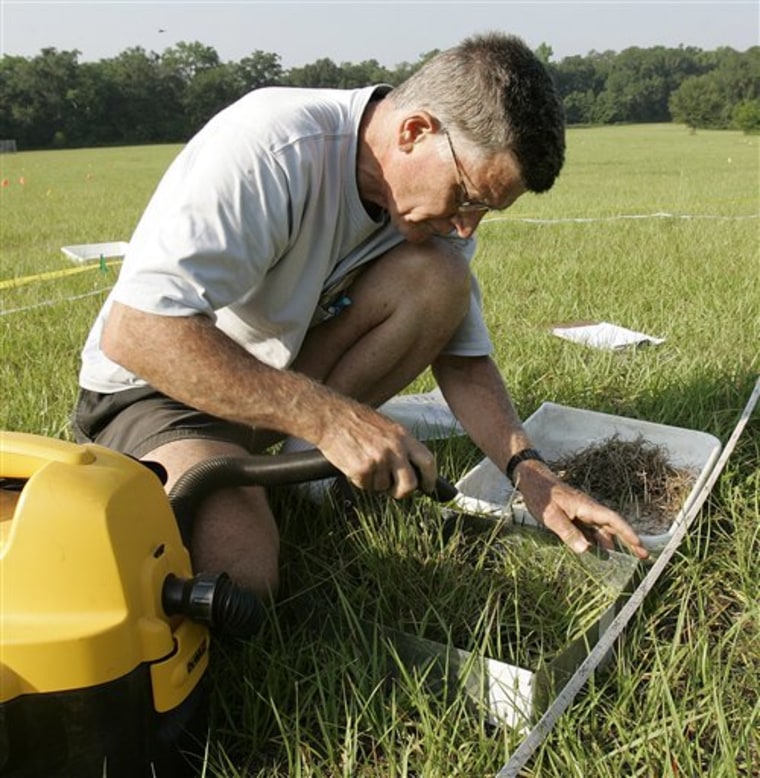The first sentence of the first chapter of Walter Tschinkel's new book says it all: "I love fire ants."
The Florida State University myrmecologist — a biologist who specializes in ants — has spent 35 years studying red imported fire ants, aggressive stinging insects that most Southerners consider a pest of the first order if not an outright scourge.
Tschinkel takes exception to that notion in "The Fire Ants." The 723-page epic, published by Harvard University Press, intersperses hard science about a complex and alien species with breezy "interludes" on his fire ant adventures and those of other researchers.
"The fire ant has been accused of almost every heinous act that people have been able to imagine, typically without any careful experimentation," Tschinkel said in an interview. "So there is this tendency to believe fire ants are capable of doing almost anything nasty."
Fire ants once were blamed for a fish kill, Tschinkel said. Researchers shoveled fire ant colonies into a pond trying to prove the fish died from eating the insects.
"Not a single fish died," Tschinkel said.
One of his interludes is about a trip to Miami to testify in a lawsuit that blamed a landlord for ant stings suffered by tenants.
The landlord won after Tschinkel told jurors no one is to blame for fire ants. He also said people should just leave them alone unless allergic to their venom. Otherwise they do no harm, he said.
"Most people hate fire arts without reservation, without reflection," he wrote. "Perhaps that is what the fire ant has to offer us — something we can all agree to hate, something about whose reprehensibility there is no argument, something we can blame and that won't argue back."
Robert Vander Meer, fire ant research leader for the federal Agriculture Research Services in Gainesville, admires Tschinkel and his work and agreed fire ants bring out people's emotions. But there's good reason for that, he said.
"If it were an innocuous pest then you wouldn't have these emotions," Vander Meer said.
Besides being deadly to people who are allergic, fire ants destroy crops, damage irrigation systems, kill wildlife, short out air conditioning systems and undermine roads with their tunnels, he said.
The U.S. Department of Agriculture estimates fire ant damage and control total $6 billion a year. But even critics concede they also can be beneficial by killing other insect pests.
To Tschinkel, though, fire ants are just another opportunistic species. "They are less invasive than we are," he said.
Like humans, they migrated to North America. Native to Argentina and Brazil they had made their way to Mobile, Ala., by 1930, apparently stowing away in ships' cargo. They have since spread across the Southeast and most recently to California.
That's been just fine for Tschinkel. "If I had worked on any number of native ants I think work like that would have been difficult if not impossible," he said.
Native ants are harder to find because they don't like disturbed areas, such as plowed fields and lawns, while fire ants thrive there.
"Humans make habitat for fire ants and fire ants are very abundant and, therefore, I'm provided with abundant research material," Tschinkel said. "My favorite phrase is `Man is fire ants' best friend.'"
Tschinkel has made some fascinating discoveries. For instance, several queens often establish a single colony, but worker ants execute all except one of the queens. He also has observed nearby colonies stealing each others' larvae and eggs, known as brood raiding.
Tschinkel, who has been stung hundreds of times, said he wants simply to advance science, not to find ways to get rid of the insects. Yet the USDA has paid for some of his research, and Vander Meer said any fire ant research helps those trying to control them.
"Walter has added tremendously to our knowledge," he said. "So, we thank Walter."
His latest project is testing a key theory in fire ant suppression — that they compete with other ants and, therefore, can be controlled by helping native species gain ground. The theory is not holding up as the experiment enters its third and final year, Tschinkel said.
He has staked out plots in the Aplachicola National Forest and a cattle ranch. Some are left undisturbed while others are mowed or plowed. Fire ants are removed from some plots and transplanted to others while the rest are left untouched.
"Removing the fire ants made no difference whatsoever to the co-occurring ants," Tschinkel said. "What was hammering the native ants was ecological disturbance."
Tschinkel's book, meanwhile, has received a glowing review from The New York Times, which praised the interludes for offering "a real glimpse of what science is and how it is done."
Harvard professor emeritus E.O. Wilson, who won a Pulitzer Prize with co-author Bert Holldobler in 1991 for "The Ants," wrote the foreword. He called "The Fire Ants" a "masterpiece" and "example of how future biology will be written."
Tschinkel shares the credit with the creatures he loves.
"They have provided me with an almost endless opportunity to engage my curiosity and to delve into the secrets of their lives," he said. "I like them in that sense. They're not cuddly."
